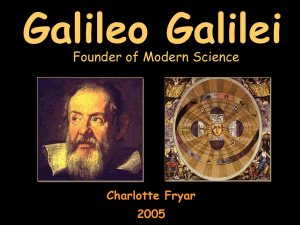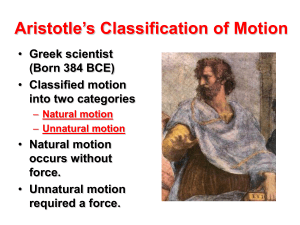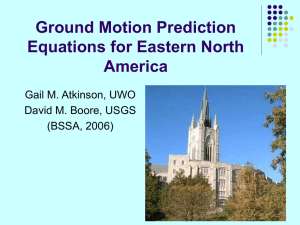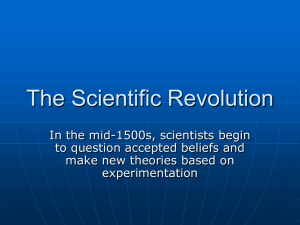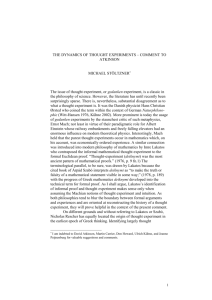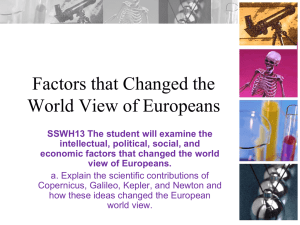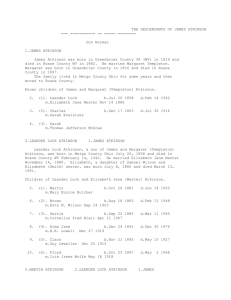Thinking about thought experiments in physics
advertisement
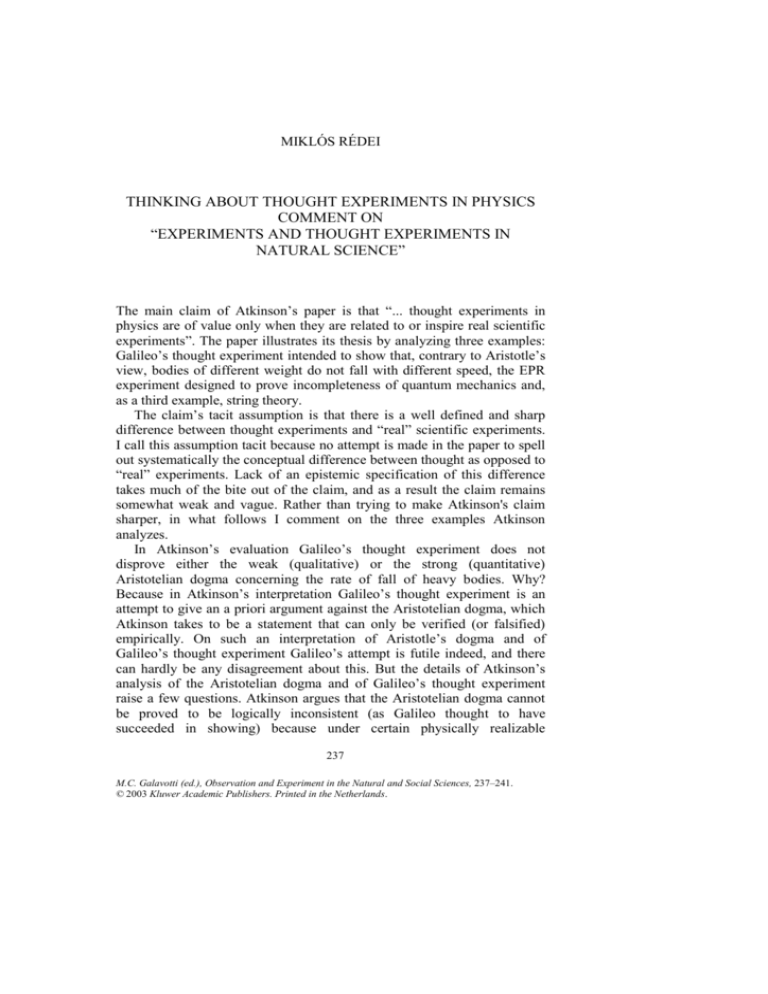
MIKLÓS RÉDEI THINKING ABOUT THOUGHT EXPERIMENTS IN PHYSICS COMMENT ON “EXPERIMENTS AND THOUGHT EXPERIMENTS IN NATURAL SCIENCE” The main claim of Atkinson’s paper is that “... thought experiments in physics are of value only when they are related to or inspire real scientific experiments”. The paper illustrates its thesis by analyzing three examples: Galileo’s thought experiment intended to show that, contrary to Aristotle’s view, bodies of different weight do not fall with different speed, the EPR experiment designed to prove incompleteness of quantum mechanics and, as a third example, string theory. The claim’s tacit assumption is that there is a well defined and sharp difference between thought experiments and “real” scientific experiments. I call this assumption tacit because no attempt is made in the paper to spell out systematically the conceptual difference between thought as opposed to “real” experiments. Lack of an epistemic specification of this difference takes much of the bite out of the claim, and as a result the claim remains somewhat weak and vague. Rather than trying to make Atkinson's claim sharper, in what follows I comment on the three examples Atkinson analyzes. In Atkinson’s evaluation Galileo’s thought experiment does not disprove either the weak (qualitative) or the strong (quantitative) Aristotelian dogma concerning the rate of fall of heavy bodies. Why? Because in Atkinson’s interpretation Galileo’s thought experiment is an attempt to give an a priori argument against the Aristotelian dogma, which Atkinson takes to be a statement that can only be verified (or falsified) empirically. On such an interpretation of Aristotle’s dogma and of Galileo’s thought experiment Galileo’s attempt is futile indeed, and there can hardly be any disagreement about this. But the details of Atkinson’s analysis of the Aristotelian dogma and of Galileo’s thought experiment raise a few questions. Atkinson argues that the Aristotelian dogma cannot be proved to be logically inconsistent (as Galileo thought to have succeeded in showing) because under certain physically realizable 237 M.C. Galavotti (ed.), Observation and Experiment in the Natural and Social Sciences, 237–241. © 2003 Kluwer Academic Publishers. Printed in the Netherlands. 238 MIKLÓS RÉDEI conditions (bodies falling in a viscous medium such as water) the “dogma” is in fact empirically true. While it is indeed true that bodies of different shape fall at different speed in a medium, this is true so obviously that one wonders whether referring to this situation has any significance. It is difficult to think that Galileo would have denied that bodies of different shape would fall at different speed in a viscous medium. Is it not the case that the disagreement between Aristotle and Galileo was about the rate of falling of bodies in the absence of any medium, i.e. in vacuum? Atkinson takes the position that even if we answer this question in the positive, Galileo’s conclusion that bodies with different weight fall at the same speed is no less a dogma than Aristotle’s because “... a physical model exists in which different bodies fall at different rates, even in vacuo. In a nonuniform gravitational field, as in the terrestrial situation, the rate of fall is a function of the distance from the centre-of-mass of the earth: a body at a higher elevation falls less quickly than one at lower elevation.” (p. 211) Again, true of course; however, it is clear from Galileo’s thought experiment that Galileo was thinking of the rate of fall of different bodies at the same location: a body at the foot of the Himalayan mountains cannot be “united” even in thought with one on the peak, and Galileo’s thought experiment assumes that the two bodies can be united. If so, what significance does the fact have for Galileo’s thought experiment that the gravitational field of the earth is nonuniform? In short: it seems that what Aristotle and Galileo were arguing about was the rate of speed of different bodies at a given location in the gravitational field in vacuum. Any reference to circumstances and situations that place the argument in a different context seems to create unnecessary and misleading complications in the evaluation of the debate between Aristotle and Galileo. The above is not to be taken as an attempt to defend Galileo’s thought experiment against Atkinson’s charge that the thought experiment is ineffectual if interpreted as an a priori argument. I am in complete agreement with Atkinson on his pointing out the major tacit assumption in Galileo’s argument: that natural speeds are mediative (p. 211). This assumption is indeed not self-evident and is in need of empirical testing, as Atkinson emphasizes. And this assumption is in fact used by Galileo in his argument. Following Gendler, Atkinson shows that if natural speed is taken to be acceleration, then natural speed can indeed be shown mediative within the framework of classical Newtonian mechanics. Since Newtonian mechanics is not a priori true, I find myself in agreement also with Atkinson’s main evaluation of Galileo’s thought experiment: “Galileo’s conclusion that all bodies fall from the same height at the same rate, if air COMMENTS ON ATKINSON 239 friction is negligible, and there is no aprreciable electrostatic or magnetic forces at work, is approximately correct; but this fact is not a consequence of pure logic, despite Salvati’s ease in discomforting the Aristotelian straw-man, Simplicio.” (p. 222) The EPR thought experiment was proposed by Einstein, Podolsky and Rosen in a relatively short but extremely influential Physical Review paper published in 1935. Atkinson’s evaluation of this thought experiment is that “... its true significance for the development of physics lies in its development from the standoff of a Gedankenexperiment and of two competing Weltanschauungen (Einstein versus Bohr) via theoretical insights (Bohm and Bell) to a genuine experiment (Aspect). Had this genuine experiment not been performed, the EPR thought experiment would have remained a fruitless stand-off.” (p. 215). There is no denying the significance of the fact that EPR-type experiments have actually been performed in the early eighties by Aspect and his co-workers. Yet, it seems to me that emphasizing only this aspect of the Aspect experiment does not exhaust the significance of the EPR thought experiment. If it were true without qualification that if Aspect’s genuine experiment “had not been performed, the EPR thought experiment would have remained a fruitless standoff”, then one would expect that after the measurement had actually been done, the standoff was resolved fruitfully. But this is not the case. The debate about whether quantum mechanics is a complete theory did not stop after the Aspect experiment had been done. Quite on the contrary, the Aspect experiments marked the beginning of a new wave of debates. Also, if the EPR thought experiment’s significance did lie exclusively in the fact that about 50 years later a similar experiment was performed, then it is difficult to explain L. Rosenfeld’s reaction to the EPR paper: “It was an onslaught [that] came down upon us as a bolt from the blue” (Jammer 1995, p. 129). That the debate about completeness of quantum mechanics raged on after Aspect’s experiment had been performed is partly due to the fact that the separation of “thought” experiments and “real” or “genuine” experiments does not seem to be as neat as one would like to think. There is far too much “thought” involved in a “real” experiment to say without any further qualification that the significance of a thought experiment lies exclusively in what it is realizable from it. Aspect’s experiment and the debate about what it confirms or falsifies is a nice example of the well known theory ladenness of “real” experiments. It also is remarkable that EPR-type correlation experiments were designed after the Aspect experiment, and they are still being made. Once I asked a leading experimental physicist whether he designs those 240 MIKLÓS RÉDEI experiments because he expects to find measurement results that contradict quantum mechanical predictions. His reply: “Of course not – I expect what quantum theory predicts”. So I am wondering whether J. Bell’s utterance (quoted by Atkinson (p. 215)) namely that he expected empirical violation of Bell’s inequalities could be considered typical in the physics community. Atkinson points out that in an EPR situation “... successive measurement results are correlated, that is the prediction” of quantum theory (p. 213), and those correlations are confirmed by experiments. Atkinson also indicates that observing correlations is not at all something exceptional or unique as long as one can conceive an explanation of them. The problem with the EPR correlations is that we do not possess a satisfactory explanation of these correlations. One has in principle two options to explain a correlation: by assuming a causal influence between the correlated events or by assuming some other factor (a common cause) that is responsible for the correlation. Formulating the need to explain correlations and identifying only these two options for an explanation is the content of what became called Reichenbach’s Common Cause Principle. This principle is not formulated in Atkinson’s paper, but its apparent violation by EPR correlations lies at the heart of the difficulty related to the EPR correlations. In the case of EPR correlations the option of explaining the correlation by assuming causal influence between the correlated events is available only at the expense of violating relativity theory since the correlated events are spacelike. But the other option also seems to be blocked by No-go theorems that spell out the impossibility of a common cause explanation of EPR correlations. The status of these No-go theorems is a controversial issue which is currently debated in the foundational literature (see (Rédei Forthcoming) for a review of the recent developments concerning the status of Reichenbach’s Common Cause Principle from the perspective of quantum correlations, and (Rédei 2002a) for partial results about spacelike correlations prediicted by relativistic quantum theory). Atkinson’s somewhat skeptical remarks about the empirical nature (hence usefulness) of string theory are based on a real concern. If a theory such as string theory aspires to be a physical theory but it “... will never be testable in practice” (p. 217), then it is indeed practically metaphysics, even if it is testable in principle. That string theory will never be testable in practice, is however too strong a statement. While Atkinson’s argument in favor of this assertion should make one very skeptical about the possibility of an empirical test of string theory because the energy per particle required for a test seems to be out of reach if one extrapolates the rate by which the available energy per particle has been increasing, this does not COMMENTS ON ATKINSON 241 entail that the energies will in the future remain unattainable. If in assessing the status of string theory one takes a Popperian position about empirical testability as a demarcation criterion, like Atkinson does, then why not accept another idea of Popper regarding the unpredictability of future as well? If one does this, the energies required for testing might be available one day. If history of science is any indication it is likely however that string theory will have long been superseded by other, perhaps even more outlandish theories by then. Department of History and Philosophy of Science, Faculty of Science Loránd Eötvös University, Budapest, Hungary REFERENCES Jammer, M. 1985. “The EPR Problem in Its Historical Development”. In P. Lahti and P. Mittelstaedt (eds.), Symposium on the Foundations of Modern Physics. 50 Years of the Einstein-Podolsky-Rosen Gedankenexperiment. Singapore: World Scientific, pp. 129– 149. Rédei, M., Summers, S.J. 2002a. “Local Primitive Causality and the Common Cause Principle in Quantum Field Theory”. Foundations of Physics 32: 335–355. Rédei, M. Forthcoming. “Reichenbach’s Common Cause Principle and Quantum Correlations”. In J. Butterfield and T. Placek (eds.), Modality, Probability and Bell’s Theorems. Dordrecht: Kluwer Academic Publishers.


